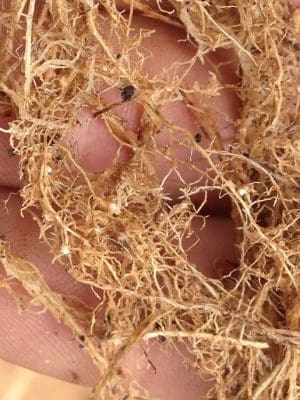THE threat from cereal cyst nematode (CCN) still exists in the southern farming regions, despite resistant cereal varieties and non-host crop rotations controlling this pest in the past.
The Grains Research and Development Corporation (GRDC) manager for diseases, Dr Friday Obanor, said CCN affected wheat, barley, oat and triticale crops and could cause yield losses of more than 70 per cent in intolerant varieties.
“The widespread adoption of resistant cereal varieties and non-host rotations has significantly reduced the problem, but if susceptible varieties are grown in continuous rotation, CCN numbers could easily increase again in certain areas,” Dr Obanor said.
CCN is most widely distributed in sandy and clay soils in South Australia and Victoria. It is not regarded as a pest in Queensland nor most of NSW but is a problem in some parts of southern NSW and Western Australia.
The first signs of CCN infection usually become apparent at early tillering, especially in late sown crops, appearing as patches of stunted yellow plants.
Patches may vary in size from one to hundreds of metres in diameter. Symptoms can be confused with severe nutrient deficiency so inspecting roots for damage is important.
Wheat and barley roots will be ‘knotted’ while oat roots appear ‘ropey’ and swollen and symptoms may be confused with herbicide damage. Root systems in severely affected plants will be retarded and shallow.
All growers, but particularly those planting CCN-susceptible cereals, should monitor CCN numbers in their paddock using a PreDicta B soil test, which can be conducted by accredited agronomists.
The test also detects a range of other important soil-borne diseases and allows growers to identify which paddocks have low/below detection CCN numbers and can therefore be safely planted to a CCN-susceptible cereal.
The new GRDC Fact Sheet, available for viewing and downloading at https://grdc.com.au/Resources/Factsheets/2017/03/Tips-and-Tactics-Cereal-Cyst-Nematode-2017, also offers the following advice:
- CCN control is achieved by avoiding or minimising susceptible cereal crops and grass weeds within the rotation. If CCN is detected in a paddock, a two-year break is required before growing a susceptible cereal;
- Good disease breaks for CCN include grass-free pulse crops, oilseed crops and legume pastures, resistant cereals, and chemical fallow to remove susceptible hosts before nematodes have produced viable eggs;
- There are many wheat, barley, oat and triticale varieties now available that are resistant to CCN. Check current cereal disease guides to determine the resistance rating of varieties (see State Government websites and National Varieties Trial Online, https://www.nvtonline.com.au);
- CCN can be identified in spring when the cysts become visible on the roots of affected plants;
- Once a crop is affected, very little can be done to protect that crop.
Source: GRDC




HAVE YOUR SAY